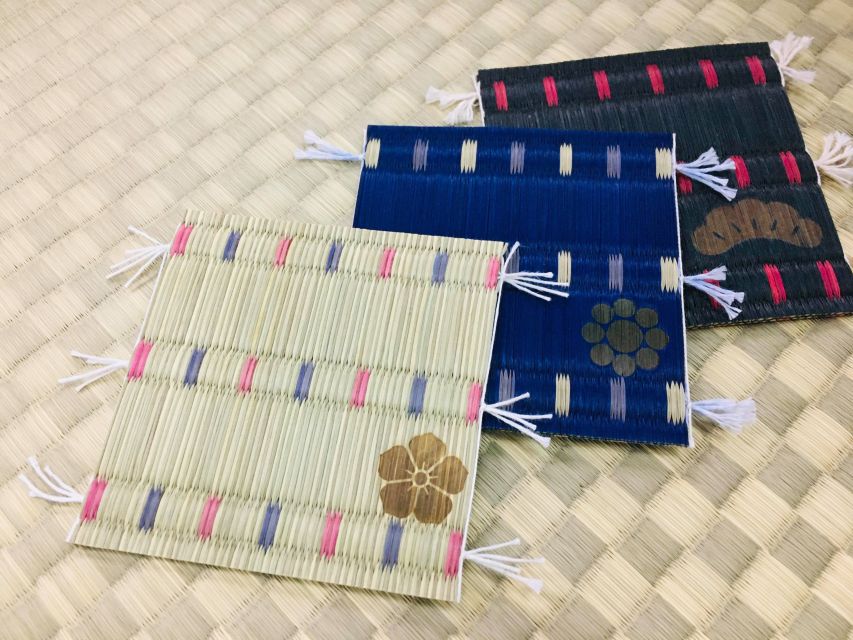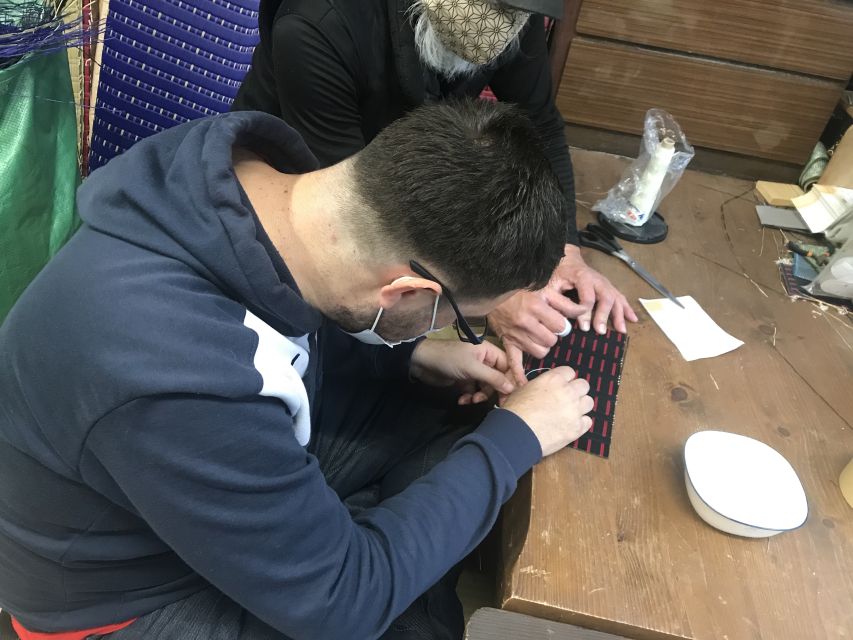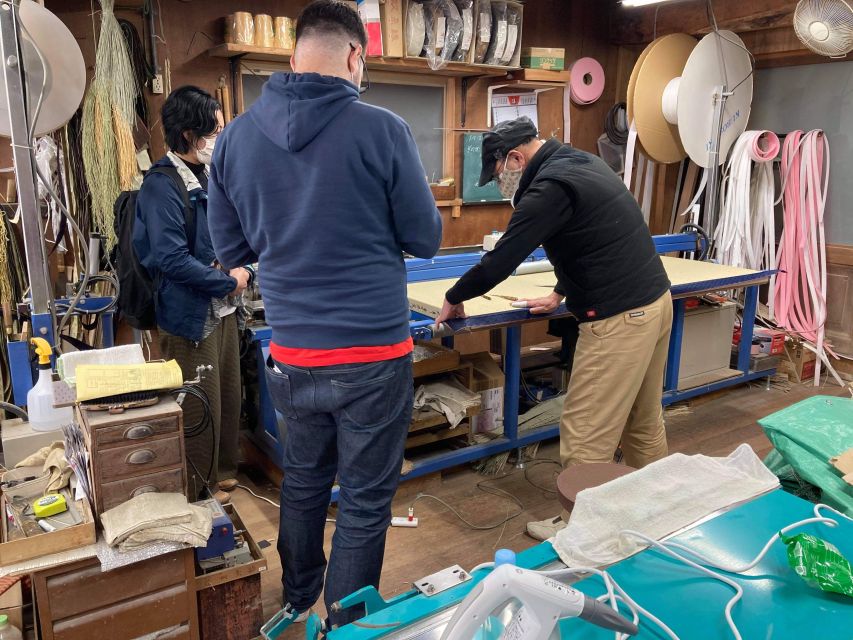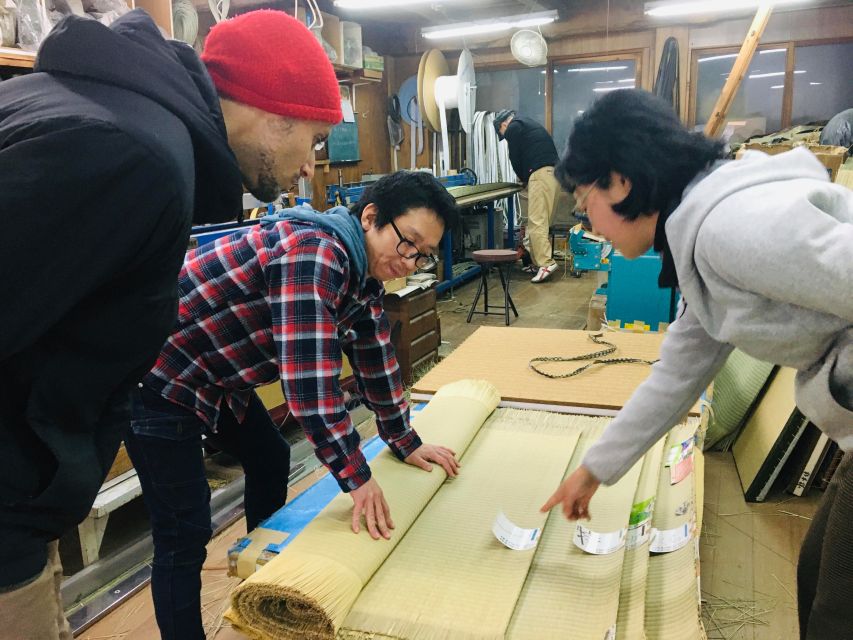In Miyazu, a picturesque town in the Kansai Region of Japan, visitors can explore the rich cultural heritage of tatami mats.
At the Tatamiya Tatsuzo Tatami Workshop, a family-owned hotel since 1927, participants have the unique opportunity to observe the traditional art of making these iconic floor mats. Led by the knowledgeable fourth-generation owner, guests not only learn about Miyazu’s fascinating history but also experience the therapeutic aroma of soft rush, a key ingredient in tatami making.
A highlight of the workshop is the chance to create a tatami mat coaster, offering hands-on insight into the intricate techniques of this ancient craft.
To complete the cultural experience, visitors can also explore the enchanting old quarter of Miyazu and even step inside an old merchant house from the Edo period.
Join us as we explore the details of this immersive journey through Miyazu’s tatami culture.
Quick Takeaways

- Participants can learn about Tatami culture and the traditional techniques used to make floor mats
- Participants have the opportunity to make their own Tatami mat coaster during the activity
- The activity takes place in Miyazu, Kansai Region, Japan and is located next to the parking lot of Miyazu Seaside Mart Mipple
- Participants can experience the atmosphere of an old merchant house and learn interesting local stories during the activity.
Not for you? Here's a few more great tours and experiences nearby.
Tatami Culture and Traditional Techniques

Tatami culture and traditional techniques can be explored and experienced through the immersive activities offered at the Tatamiya Tatsuzo Tatami Workshop in Miyazu, Japan.
This workshop provides a unique opportunity to learn about the tatami mat production process and understand the cultural significance of these traditional floor mats. Participants can observe the skilled craftsmen as they meticulously weave together the soft rush and rice straw that form the foundation of each tatami mat. They’ll also gain insights into the history and craftsmanship of tatami making from the knowledgeable fourth-generation owner of the workshop.
Tatami mats have been an integral part of Japanese homes, inns, shrines, and temples for centuries, symbolizing comfort, elegance, and a connection to the past. By engaging in these activities, visitors can deepen their appreciation for tatami culture and gain a firsthand understanding of the traditional techniques involved in their production.
You can also read our reviews of more tours and experiences in miyazu.
Making Your Own Tatami Mat Coaster

Participants at the Tatamiya Tatsuzo Tatami Workshop in Miyazu, Japan can actively engage in the production process by crafting their own tatami mat coaster. This hands-on activity allows visitors to experience the artistry and skill required to create these traditional Japanese floor mats.
Here are three things to know about making your own tatami mat coaster:
- Unique Designs: Participants have the opportunity to choose from a variety of tatami mat designs, each with its own intricate patterns and colors. This allows for a personalized and one-of-a-kind coaster creation.
- Traditional Techniques: Under the guidance of the workshop’s experienced craftsmen, you will learn the traditional techniques used in making tatami mats. From measuring and cutting the rush grass to weaving and tying the materials together, this activity provides an authentic insight into the tatami industry in Japan.
- Take Home a Souvenir: At the end of the workshop, participants can proudly take home their handmade tatami mat coaster as a special memento of their visit. It serves as a reminder of the craftsmanship and cultural significance of tatami mats in Japanese traditions.
Exploring the Old Quarter of Miyazu

Visitors to Miyazu can enjoy the rich history and charm of the old quarter. They can explore traditional merchant houses and experience the nostalgic atmosphere of a bygone era.
The old quarter of Miyazu offers more than just a glimpse into the past. It’s also a hub for exploring local cuisine and the traditional crafts of Miyazu.
As visitors stroll through the narrow streets, they’ll find quaint shops and restaurants offering delicious local dishes such as sushi, sashimi, and tempura.
They can also discover the traditional crafts of Miyazu, including pottery, lacquerware, and weaving. These crafts have been passed down through generations and showcase the skill and artistry of the local artisans.
Exploring the old quarter of Miyazu is a delightful way to take in the history, culture, and flavors of this charming Japanese town.
History of Tatamiya Tatsuzo Tatami Workshop
.jpg)
The rich heritage of Miyazu’s traditional crafts extends to the history of the esteemed Tatamiya Tatsuzo Tatami Workshop. This workshop, which has been in operation since 1927, is currently run by the fourth generation owner.
Here are three key points about the history of Tatamiya Tatsuzo Tatami Workshop:
- Miyazu’s cultural heritage: The workshop plays a significant role in preserving Miyazu’s cultural heritage by continuing the traditional art of tatami making.
- History of tatami making techniques: The workshop showcases the traditional way of making tatami mats, allowing participants to observe the intricate techniques passed down through generations.
- The present owner’s knowledge: The current owner of the Tatamiya Tatsuzo Tatami Workshop possesses a profound knowledge of Miyazu’s history, making the experience even more informative and enriching for participants.
Through the Tatamiya Tatsuzo Tatami Workshop, visitors can gain a deeper understanding of Miyazu’s cultural heritage and the history of tatami making techniques.
Therapeutic Effects of Soft Rush Aroma

Continuing the exploration of Miyazu’s traditional crafts, the soft rush aroma used in tatami making has therapeutic and relaxing effects. Soft rush, also known as Igusa in Japanese, is a type of wetland plant that’s woven into the mats to create the distinct texture and scent.
The benefits of using soft rush in aromatherapy are well-known. Its fragrance has a calming effect on the mind and body, reducing stress and promoting relaxation.
Along With its therapeutic properties, tatami mats hold significant cultural significance in Japanese homes. They’ve been used for centuries, not only for their functionality but also for their symbolism of Japanese tradition and elegance.
The soft rush aroma adds to the overall sensory experience and creates a serene atmosphere in tatami rooms, making them an essential part of Japanese living.
Traditional Way of Making Tatami Mats
.jpg)
The process of making tatami mats involves a series of traditional techniques that have been passed down for centuries.
- Measurement and Cutting: The craftsmen use precise measurements to cut the rush straw and the woven rush matting into the required sizes for the tatami mats.
- Assembly and Stitching: The rush straw is carefully layered onto the woven rush matting, and then the edges are folded and stitched together using a special needle and thread made from hemp or cotton.
- Finishing Touches: Once the tatami mat is assembled, it goes through a process of pressing and drying to ensure its shape and durability. Lastly, the corners are neatly finished with decorative cloth covers.
These traditional techniques, combined with the meticulous craftsmanship of the artisans, result in the creation of beautiful and functional tatami mats that are an integral part of Japanese culture.
Local Stories and Interesting Facts
.jpg)
One interesting fact about Miyazu is that it is home to Tatamiya Tatsuzo Tatami Workshop, which has been operating since 1927. This workshop is deeply rooted in the local community and holds significant cultural significance. The present owner of the workshop, now in its fourth generation, has a profound knowledge of Miyazu’s history and can share interesting local stories during the activity. The workshop offers participants the opportunity to observe the traditional way of making tatami mats, which have been used in Japanese houses, travel inns, shrines, and temples for centuries. Plus, the workshop allows participants to experience the exquisite atmosphere of a tatami room in one of the most successful old merchant houses from the Edo period. This combination of craftsmanship, local legends, and cultural significance makes the Tatamiya Tatsuzo Tatami Workshop a must-visit destination in Miyazu.
| Local Legends | Cultural Significance |
|---|---|
| – Deeply rooted in the local community | – Traditional craft with centuries of history |
| – Home to interesting local stories | – Exquisite atmosphere of an Edo period merchant house |
| – Fourth generation owner with profound knowledge of Miyazu history | – Symbol of Japanese culture and craftsmanship |
| – Reflects the traditional way of life in Miyazu |
Experiencing a Tatami Room in an Old Merchant House
.jpg)
Experiencing the exquisite atmosphere of a tatami room in an old merchant house, participants can enjoy the traditional way of life in Miyazu at the Tatamiya Tatsuzo Tatami Workshop. Here are three reasons why this experience is worth having:
-
Exquisite Craftsmanship:
The tatami mats found in Japanese houses, travel inns, shrines, and temples have been crafted with meticulous attention to detail for centuries. At Tatamiya Tatsuzo Tatami Workshop, participants can observe the traditional techniques used to make these floor mats and appreciate the exquisite craftsmanship that goes into their creation. -
Cultural Significance:
Tatami mats hold great cultural significance in Japan, symbolizing the country’s history and way of life. By stepping into a tatami room in an old merchant house, participants can gain a deeper understanding of Japanese culture and traditions. -
Immersive Experience:
The ambiance of an old merchant house from the Edo period adds to the authenticity of the experience. Participants can feel the soft rush used in tatami making, which has a therapeutic and relaxing effect. This immersive encounter allows participants to truly appreciate the beauty and serenity of a tatami room.
Frequently Asked Questions
.jpg)
How Long Has Tatamiya Tatsuzo Tatami Workshop Been in Operation?
Tatamiya Tatsuzo Tatami Workshop, with a rich history, has been operating for several generations. This traditional craft is of great importance in Japan, reflecting the country’s deep appreciation for preserving cultural practices.
What Is the Product ID of the Activity?
The product ID of the activity is 414110. The activity fee includes the guide fee, experience fee, and one tatami coaster per participant. Taxes are also included in the price.
Where Is the Meeting Point for the Activity?
The meeting point for the activity is the Tourist Information Center located next to the parking lot of Miyazu Seaside Mart Mipple. Participants can easily find the address on the voucher or by searching for Michinoeki Miyazu on Google Maps.
Are Meals and Beverages Included in the Activity Fee?
No, meals and beverages are not included in the activity fee. Participants with dietary restrictions or special requests should make arrangements beforehand. Additional meals and beverages can be purchased separately at the participant’s expense.
How Many Participants Can Take Part in the Activity?
Participants can select the number of participants for the activity. The group size can be checked before booking, ensuring availability for everyone interested in taking part in the Tatami Workshop, Coaster Making, and Old House Visit.
The Sum Up
In Miyazu, visitors can enjoy the rich cultural heritage of tatami mats at the Tatamiya Tatsuzo Tatami Workshop. This unique activity offers the chance to learn about the history of Miyazu while experiencing the therapeutic aroma of soft rush. Making a tatami mat coaster provides hands-on insight into the intricate techniques of this traditional craft.
Plus, a leisurely stroll through the old quarter allows visitors to soak up the atmosphere of an old merchant house from the Edo period.



